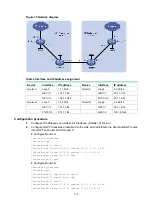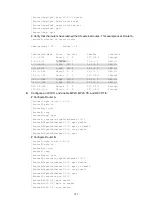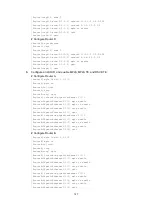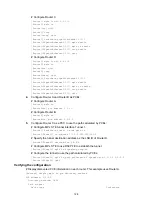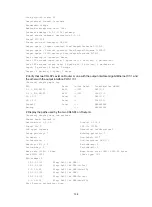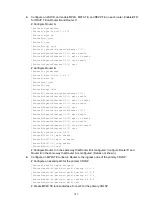
128
# Configure Router C.
[RouterC] mpls lsr-id 3.3.3.3
[RouterC] mpls te
[RouterC-te] quit
[RouterC] rsvp
[RouterC-rsvp] quit
[RouterC] interface gigabitethernet 1/1/1
[RouterC-GigabitEthernet1/1/1] mpls enable
[RouterC-GigabitEthernet1/1/1] mpls te enable
[RouterC-GigabitEthernet1/1/1] rsvp enable
[RouterC-GigabitEthernet1/1/1] quit
# Configure Router D.
[RouterD] mpls lsr-id 4.4.4.4
[RouterD] mpls te
[RouterD-te] quit
[RouterD] rsvp
[RouterD-rsvp] quit
[RouterD] interface gigabitethernet 1/1/1
[RouterD-GigabitEthernet1/1/1] mpls enable
[RouterD-GigabitEthernet1/1/1] mpls te enable
[RouterD-GigabitEthernet1/1/1] rsvp enable
[RouterD-GigabitEthernet1/1/1] quit
4.
Configure Router A and Router B as PCEs:
# Configure Router A.
[RouterA] mpls te
[RouterA-te] pce address 1.1.1.1
# Configure Router B.
[RouterB] mpls te
[RouterB-te] pce address 2.2.2.2
5.
Configure Router C as a PCC to use the path calculated by PCEs:
# Configure MPLS TE tunnel interface Tunnel 1.
[RouterC] interface tunnel 1 mode mpls-te
[RouterC-Tunnel1] ip address 7.1.1.1 255.255.255.0
# Specify the tunnel destination address as the LSR ID of Router D.
[RouterC-Tunnel1] destination 4.4.4.4
# Configure MPLS TE to use RSVP-TE to establish the tunnel.
[RouterC-Tunnel1] mpls te signaling rsvp-te
# Configure the tunnel to use the path calculated by PCEs.
[RouterC-Tunnel1] mpls te path preference 2 dynamic pce 1.1.1.1 2.2.2.2
[RouterC-Tunnel1] quit
Verifying the configuration
# Display discovered PCE information on each router. This example uses Router A.
[RouterA] display mpls te pce discovery verbose
PCE address: 2.2.2.2
Discovery methods: OSPF
Path scopes:
Path scope Preference






